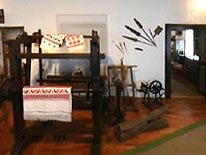|
Head: Melita Habdija, curator
| The
permanent display |
 |
 |
The Ethnographic Collection is one of the largest collections
of the Municipal Museum. It was started at the very beginning
of the Museum, in 1952. It was part of the then newly
founded Native Collection which, during the following
ten years, grew into the Museum and the Ethnographic Collection
became an independent collection. The largest number of
items relate to textile craftsmanship of the Križevci
surroundings and the area around Kalnik. Tools used in
the manufacturing of flax and hemp are also on display.
The Collection contains a large number of pottery exhibits,
objects for everyday use, and dishes made of wood and
straw. Items of clothes and textile products are best
represented: there are towels and authentic vilans
or vilajns - bedspreads and bed linen with ornaments
subsequently woven into them). The traditional costumes
of the area were white, plain and relatively modest. The
only richly decorated items were head-worn accessories
for women. Women of the area used to wear a poculica
(paculjica) - a square headdress with rich ornaments
embroidered or woven over it. Pottery and pottery products
used in local households were mostly purchased at local
fairs from the potters of Križevci and travelling potters
of Zagorje.
The Ethnographic Collection contains several dozens of
pottery products and only a small part is put on display.
Apart from pottery, the households used wooden dishes
and dishes made of other materials, such as bark or wicker.
Those dishes are also included in the Collection. An example
of annual customs of the area is a Christmas table with
straw under it and a candle in žitko (a mixture
of grains). On the table there are Christmas bread, grain,
and all that is supposed to be there on Christmas Eve.
Easter customs are depicted through typical Easter eggs
and a model Easter bonfire - vuzmica or vuzmenka.
The tradition of bonfires is still alive in the area around
Kalnik and very early every Easter morning people gather
around the bonfire celebrating Easter - the time of joy.
|
|
|